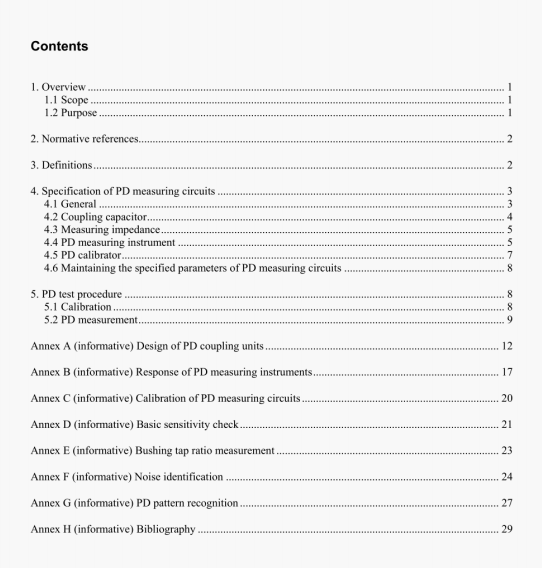IEEE C57.113:2010 pdf free download.IEEE Recommended Practice for Partial Discharge Measurement in Liquid-Filled Power Transformers and Shunt Reactors.
NOTE 2—To eliminate stochastically appearing noise pulses at comparatively low rcpetition ratejor instance one pulse per cycle of the applied ac test voltage, some PD detectors arc equipped with special features for noise suppression which may reject pulses having a repetition rate below 100 lIz. Care should be taken when using this instrumentation because PD pulses of high magnitude may not be recognized if they do not ignite in each half-cycle of the applied ac test voltage. To avoid such erroneous measurements, a visualization of the phase-rcsok’ed PD pulses is strongly recommended using a suitable display unit, such as a scope or a computer.
NOTE 3—The specified pulse train response is appropriate only for ac test voltages where the frequency may range between 40 Hz and 400 Hz. For dc test voltages or test voltages composed by ac and dc voltages, it is recommended to evaluate the number versus the magniwde of PD pulses.
4.4.3 Display unit
In addition to the measurement of the apparent charge level by means of analog or digitil lnetei it recommended to display the phase—resolved PD patterns by means of a suitable display unit. This may assist not only the identification and classification of harmful PD defects but also the discrimination of dishirbing electromagnetic interferences, which are often not phase-correlated.
4.4.4 Basic sensitivity
The basic sensitivity should be determined by means of calibrating pulses specified in 4.6, which are injected into the input of the measuring impedance connected to the PD measuring instrument via the associated measuring cable. A calibrating charge of 50 pC should cause a minimum deflection of 50% of the full reading of the indicating instrument or of the optional display unit.
4.4.5 Linearity
The linearity should be determined by means of calibrating pulses specified in 4.6, which should be in1eetej in the measuring impedance connected via the associated measuring cable to the PD measuring instniment I h IneJsanng sensitivity should be adjusted such that the full reading (100%) is obtained for an injected calibrating hwe of 500 pC. After that the magnide of the calibrating charge should be reduced stepwise by 100 pC. Under this condition the values indicated by the PD measuring instrument should not deviate by more than ±10% from the true magnitudes of the injected pulse charges.
4.5 PD calibrator
The PD calibrator is intended for the simulation of the charge transfer from the PD source to the terminals of the test
oject: see Annex C. To generate artificial PD pulses required for this purpose, the calibrator is generally equipped with a pulse generator connected in series with a calibrating capacitor, C0: see Figure 1. The pulse generator produces fast rising step voltages of known magnitudes, V0. Therefore the calibrating charge is given by Equation (2):
The PD calibrator should meet the requirements of IEC 60270. To adjust the desired magnitude of the calibrating charge. g0. the magnitude of the voltage step, V0, and the capacitance of the calibrating capacitor.
IEEE C57.113:2010 pdf free download
